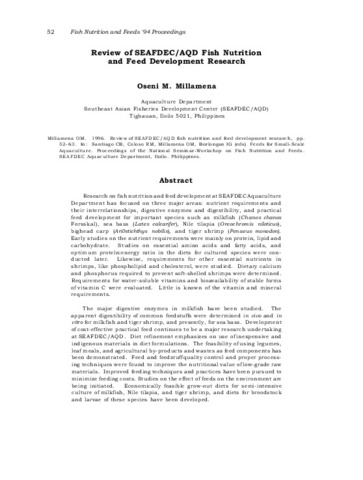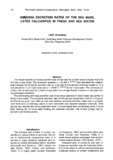Localization of enzymes in the digestive tract during the larval to early juvenile stages of sea bass (Lates calcarifier Bloch)
| dc.contributor.author | Minjoyo, Herno | |
| dc.contributor.author | Tan-Fermin, Josefa D. | |
| dc.contributor.author | Macaranas, Julie M. | |
| dc.date.accessioned | 2024-11-20T07:46:14Z | |
| dc.date.available | 2024-11-20T07:46:14Z | |
| dc.date.issued | 2003 | |
| dc.identifier.citation | Minjoyo, H., Tan-Fermin, J. D., & Macaranas, J. M. (2003). Localization of enzymes in the digestive tract during the larval to early juvenile stages of sea bass (Lates calcarifier Bloch). Indonesian Fisheries Research Journal, 9(1), 46-53. | en |
| dc.identifier.issn | 0853-8980 | |
| dc.identifier.uri | http://hdl.handle.net/10862/6569 | |
| dc.description.abstract | The onset of digestive enzymes in the various regions of the digestive tract of sea bass, Lates calcarifer (Bloch) at days 0. 2, 5, 10, 20, 30, and 40 after hatching was investigated. This study aims to correlate which enzymes are detectable in stated regions of the developing gut and to relate this pattern to the feeding habit of sea bass. Alkaline phosphatase and esterase were localized in the intestine of the 2 day old larvae. At 5 days post-hatching, esterase was present in the esophagus. At the beginning of metamorphosis (20-days post-hatching), alkaline phosphatase, esterase, and amino peptidase were localized in the pyloric caeca. Aminopeptidase's and lipase were observed in the brush border of the intestinal epithelial cells. At the end of metamorphosis (30-days-post-hatching), all enzymes investigated in this study were present. Esterase was demonstrated in the columnar cells of the stomach while lipase and amylase were observed in both columnar cells and gastric glands. Protease and amylase were present in the pyloric caeca and intestine. During the early juvenile stage (40-days-post-hatching), esterase was localized in the gastric glands of the stomach. The appearance of esterase activity as early as day 2 was correlated with endogenous to zooplanktivorous feeding. In the same manner, the presence of aminopeptidase's, lipase, protease, and amylase at day 20 to 30 onwards was related to a change in feeding habit of sea bass from zooplanktivorous to real carnivorous. The findings of this study demonstrate the need for basic studies for feed formulation and management of the fish. | en |
| dc.language.iso | en | en |
| dc.publisher | Agency for Marine and Fisheries Research and Development | en |
| dc.subject | sea bass | en |
| dc.subject | Lates calcarifer | en |
| dc.subject | alkaline phosphatase | en |
| dc.subject | aminopeptidase | en |
| dc.subject | lipases | en |
| dc.subject | amylases | en |
| dc.subject.lcsh | Digestive enzymes | en |
| dc.title | Localization of enzymes in the digestive tract during the larval to early juvenile stages of sea bass (Lates calcarifier Bloch) | en |
| dc.type | Article | en |
| dc.citation.volume | 9 | en |
| dc.citation.issue | 1 | en |
| dc.citation.spage | 46 | en |
| dc.citation.epage | 53 | en |
| dc.citation.journalTitle | Indonesian Fisheries Research Journal | en |
| dc.subject.asfa | sea bass culture | en |
| dc.subject.asfa | metamorphosis | en |
| dc.subject.asfa | larvae | en |
| dc.subject.asfa | enzyme activity | en |
| dc.subject.asfa | esterases | en |
| dc.subject.asfa | proteases | en |
| dc.subject.scientificName | Lates calcarifer | en |
| local.subject | digestive enzymes | en |
| local.subject | sea bass | en |
| local.subject | larvae | en |
| local.subject | enzyme activity | en |
Files in this item
| Files | Size | Format | View |
|---|---|---|---|
|
There are no files associated with this item. |
|||
This item appears in the following Collection(s)
-
Journal Articles [1229]
These papers were contributed by Department staff to various national and international journals.



